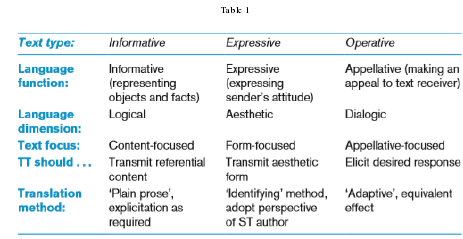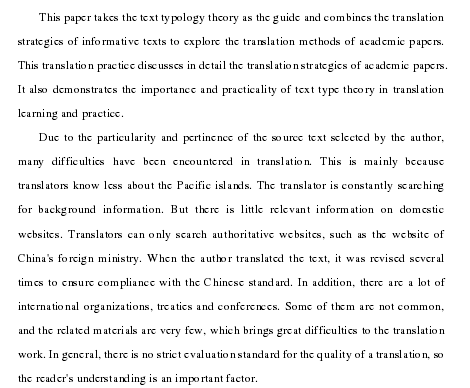
Chapter 1 Introduction
1.1 Introduction to Source Text
The original paper comes from a famous foreign journal, Asia & the pacific policy studies. It is an academic paper on foreign aid and diplomacy of Pacific islands. Asia and the Pacific Policy Studies published by John Wiley & Sons Australia, Ltd and Crawford School of Public Policy at The Australian National University. The translation task is from the Pacific Islands Research Center of Liaocheng University.
The text contains a large amount of organizations, treaties and institutions. In addition, it also contains a lot of tables and graphics. The translator not only needs to complete the translation, but also handles the tables in the text. The difficulties in the translation process are mainly the following aspects. On the one hand, the text covers many professional vocabularies, usages and expressions. This requires the translator to have a certain background knowledge of the subject. Ensure the accuracy of the translation by consulting relevant information. Accuracy means that the thesis should correctly reflect the objective things and appropriately express the author's thoughts and feelings(李力,2005:107). The content of academic papers is objective things, subject theory, and viewpoints, so the language is required to be accurate and rigorous. On the other hand, there are many long sentences in the text. It requires the translator to have strong analytical and logical thinking skills. The translator should know clear about grammar and be able to take correct translation methods that based on the correct judgment of the logical structure of the sentence. At the same time, in the translation process, the translator should also correctly understand the differences between English and Chinese. The translator should ensure that the translation is fluent and standardized.
........................
1.2 Significance of the Study
In the 1930s, China began to pay attention to Pacific island countries. From the founding of China in 1949 to the end of the 20th century, domestic research on Pacific island countries has been slowly developing. In the 1980s, independent Pacific island countries gradually increased, such as Vanuatu, the Marshall Islands and the Federated States of Micronesia. With the continuous independence of the Pacific island countries, the United States and the Soviet Union also stepped up their struggle for the region.
Since twenty-first Century, the study of Pacific island countries has entered a period of rapid development. The reason is that, China attaches great importance to its cooperative relations with the Pacific islands, and strengthens its contacts and exchanges in the political, economic, cultural and educational fields. Second, the State encourages scholars to study regional countries, including the Pacific islands. Relevant papers in China have also appeared significantly, and high-quality monographs on Pacific islands have published. At the same time, the research institutions of Pacific islands began to increase. The related research results are also more comprehensive. However, domestic research on Pacific islands is still in the development stage. And the understanding of internal affairs, diplomacy and social development of Pacific islands are insufficient. The theoretical and practical research on the development, diplomatic relations and economic cooperation between China and the Pacific islands need to be upgraded. And the challenges facing the academic community are still not optimistic. To make a breakthrough in the research of Pacific islands, we should not only study from the perspective of China, but also grasp the current situation of Western research, strengthen exchanges with the outside world and upgrade the level of research.
................................
Chapter 2 Text Typology Theory
In 1934, the German functional linguist Carl Buller summarized the three functions of language. In 1971, the representative of the German functionalist school, Katarina Reiss, based on Buhler's theory, first proposed the theory of text types and corresponding translation strategies in his book Translation Criticism-the Potentials & Limitations. Reiss’s early works about text typology theory and linguistic functions draw on achievements of the pragmatic branch of linguistics, and the text type of a text is determined on the basis of the function of language in the text (Gentzler Edwin,2001:69)
According to the function of the text, Reiss divides the text into three types: informative, expressive and appellative. She links the three functions to their corresponding language ‘dimensions’ and to the text types or communicative situations in which they are used. These links can be seen in Table1(Jeremy Munday, 2001:112).

.........................
Chapter 3 Translation Process .............................. 8........................
1.2 Significance of the Study
In the 1930s, China began to pay attention to Pacific island countries. From the founding of China in 1949 to the end of the 20th century, domestic research on Pacific island countries has been slowly developing. In the 1980s, independent Pacific island countries gradually increased, such as Vanuatu, the Marshall Islands and the Federated States of Micronesia. With the continuous independence of the Pacific island countries, the United States and the Soviet Union also stepped up their struggle for the region.
Since twenty-first Century, the study of Pacific island countries has entered a period of rapid development. The reason is that, China attaches great importance to its cooperative relations with the Pacific islands, and strengthens its contacts and exchanges in the political, economic, cultural and educational fields. Second, the State encourages scholars to study regional countries, including the Pacific islands. Relevant papers in China have also appeared significantly, and high-quality monographs on Pacific islands have published. At the same time, the research institutions of Pacific islands began to increase. The related research results are also more comprehensive. However, domestic research on Pacific islands is still in the development stage. And the understanding of internal affairs, diplomacy and social development of Pacific islands are insufficient. The theoretical and practical research on the development, diplomatic relations and economic cooperation between China and the Pacific islands need to be upgraded. And the challenges facing the academic community are still not optimistic. To make a breakthrough in the research of Pacific islands, we should not only study from the perspective of China, but also grasp the current situation of Western research, strengthen exchanges with the outside world and upgrade the level of research.
................................
Chapter 2 Text Typology Theory
In 1934, the German functional linguist Carl Buller summarized the three functions of language. In 1971, the representative of the German functionalist school, Katarina Reiss, based on Buhler's theory, first proposed the theory of text types and corresponding translation strategies in his book Translation Criticism-the Potentials & Limitations. Reiss’s early works about text typology theory and linguistic functions draw on achievements of the pragmatic branch of linguistics, and the text type of a text is determined on the basis of the function of language in the text (Gentzler Edwin,2001:69)
According to the function of the text, Reiss divides the text into three types: informative, expressive and appellative. She links the three functions to their corresponding language ‘dimensions’ and to the text types or communicative situations in which they are used. These links can be seen in Table1(Jeremy Munday, 2001:112).

.........................
3.1 Preparation ............................... 8
3.2 Translation ................................... 9
3.3 Proofreading and Reversion....................................... 9
Chapter 4 Case Analysis .................................. 11
4.1 Word Translation .................................... 11
4.2 Sentence Translation ........................ 13
Chapter 5 Summary.................................... 24
Chapter 4 Case Analysis
4.1 Word Translation
It is evident that there is no fixed pattern of word-for-word transformation,no matter in E-C or C-E translation (许建平, 2012: 22) . Generally speaking,the equivalence between English and Chinese at word level may be categorized as follows:word-for-word equivalence,one word with multiple equivalents of the same meaning,one word with several equivalents of different meanings,equivalents interwoven with one another,words without corresponding equivalents. Since the meaning of English words is unfixed,it is up to the translator to single out the right wording in light of a given context (许建平, 2012: 23).
4.1 Word Translation
It is evident that there is no fixed pattern of word-for-word transformation,no matter in E-C or C-E translation (许建平, 2012: 22) . Generally speaking,the equivalence between English and Chinese at word level may be categorized as follows:word-for-word equivalence,one word with multiple equivalents of the same meaning,one word with several equivalents of different meanings,equivalents interwoven with one another,words without corresponding equivalents. Since the meaning of English words is unfixed,it is up to the translator to single out the right wording in light of a given context (许建平, 2012: 23).
Example 1:Territories have been excluded from this analysis because of the difficulty to distinguish between what would simply be classified as a resource transfer and what could be classified as foreign aid. The resource transfers to some Territories (such as New Caledonia and French Polynesia) would also significantly distort the findings of this paper without clearly making this distinction, which is beyond the ability of this paper to provide.
......................
......................
Chapter 5 Summary

reference(omitted)
